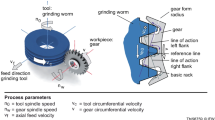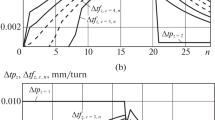Abstract
This work presents a digital graphic scanning (DGS) method, based on computer scanning graphics, to generate a grinding profile avoiding the difficulties appeared from the complex equations of the contact line. First the enveloping surface between the forming tool (rotor) profile and its corresponding cutting locus was developed, then based on Bresenham algorithm, the best possible pixels of the enveloping surface in the pixel matrix of screen were demonstrated using a specified color. Finally, the grinding profile data of the rotor (forming tool) were collected by scanning the pixel matrix of screen, capturing the coordinates of the indicated color of the best possible pixels. Comparing the analytical gearing envelope method and the DGS method, the feasibility of the DGS method was indicated. The DGS method was shown as a precise, rapid, efficient and stable computing tool to generate a grinding profile. In addition, such an approach can be applied in designing other similarly conjugated products such as gears, perpetual screws and milling cutters.
Similar content being viewed by others
Abbreviations
- S r :
-
coordinate system of rotor
- S g :
-
coordinate system of forming tool
- z r :
-
rotation axis of rotor
- z g :
-
rotation axis of forming tool
- a :
-
center distance between zr and zg
- ψ :
-
shaft angle between zr and zg
- t :
-
parameter of arc length
- e :
-
Revolving direction
- p :
-
helix parameter
- P z :
-
lead of rotor
- φ :
-
rotation angle of the forming tool
- u :
-
slope of linear
- v :
-
intercept of linear in y direction
- S :
-
enveloping surface
- k :
-
slope of profile
- x s , y s :
-
resolution of the screen
- K 1, K 2 :
-
magnification
References
Litvin, F. L., “Gear Geometry and Applied Theory,” PTR Prentice Hall, pp. 674–691, 1994.
Litvin, F. L. and Feng, P. H., “Computerized Design, Generation, and Simulation of Meshing of Rotors of Screw Compressor,” Mechanism and Machine Theory, vol. 32, no. 2, pp. 137–160, 1997.
Xing, Z. W., “Screw Compressors: Theory, Design and Application,” China Machine Press, pp. 17–24, 2000. (In Chinese)
Stosic, N., Smith, I., and Kovacevic, A., “Screw Compressors: Mathematical Modelling and Performance Calculation”, Springer Science & Business Media, pp. 45–48, 2005.
Stosic, N., Smith, I. K., Kovacevic, A., and Mujic, E., “Geometry of Screw Compressor Rotors and their Tools,” Journal of Zhejiang University SCIENCE A, vol. 12, no. 4, pp. 310–326, 2011.
Stoši, N., “On Gearing of Helical Screw Compressor Rotors,” Proceedings of the Institution of Mechanical Engineers, Part C: Journal of Mechanical Engineering Science, vol. 212, no. 7, pp. 587–594, 1998.
Wei, J., Zhang, Q., Xu, Z., and Lyu, S., “Study on Precision Grinding of Screw Rotors using CBN Wheel,” Int. J. Precis. Eng. Manuf., vol. 11, no. 5, pp. 651–658, 2010.
Wei, J., Sun, Q., Sun, X., and Sun, W., “A Study on Rotor Profiles Design for a Novel Twin-Screw Kneader,” Int. J. Precis. Eng. Manuf., vol. 14, no. 3, pp. 451–459, 2013.
Wu, B. H., Zhang, J., Yang, J., and Zhang, D., “Calculation Method for Edge Shape of Forming Wheel for Screw Rotors Machining,” Journal of Mechanical Engineering, vol. 48, no. 19, pp. 192–198, 2012. (In Chinese)
Liang, X. C., Zhao, M., Yoshino, H., Li, Y. Y., and Zhou, Y. S., “Study on the Gear and Cutter Manufacture,” Chongqing University Press, pp. 107–119, 2001. (In Chinese)
Gofdfarb, V. I. and Lunin, S. V., and Trubachev, E. S., “Direct Digital Simulation for Gears Volume 1,” http:// wwwstepanlunincom/book1html (Accessed 23 NOV 2015)
Di Puccio, F., Gabiccini, M., and Guiggiani, M., “Alternative Formulation of the Theory of Gearing,” Mechanism and Machine Theory, vol. 40, no. 5, pp. 613–637, 2005.
Spitas, V., Costopoulos, T., and Spitas, C., “Fast Modeling of Conjugate Gear Tooth Profiles using Discrete Presentation by Involute Segments,” Mechanism and Machine Theory, vol. 42, no. 6, pp. 751–762, 2007.
Wu, Y. R., Fong, Z. H., and Zhang, Z. X., “Simulation of a Cylindrical Form Grinding Process by the Radial-Ray Shooting (RRS) Method,” Mechanism and Machine Theory, vol. 45, no. 2, pp. 261–272, 2010.
Bresenham, J. E., “Algorithm for Computer Control of a Digital Plotter,” IBM Systems Journal, vol. 4, no. 1, pp. 25–30, 1965.
Kong, L. D., “Basics Tutorial of Computer Graphics,” Beijing: Tsinghua University Press, pp. 55–69, 2008. (In Chinese)
Author information
Authors and Affiliations
Corresponding author
Rights and permissions
About this article
Cite this article
Shen, Z., Yao, B., Teng, W. et al. Generating grinding profile between screw rotor and forming tool by digital graphic scanning (DGS) method. Int. J. Precis. Eng. Manuf. 17, 35–41 (2016). https://doi.org/10.1007/s12541-016-0005-0
Received:
Revised:
Accepted:
Published:
Issue Date:
DOI: https://doi.org/10.1007/s12541-016-0005-0




